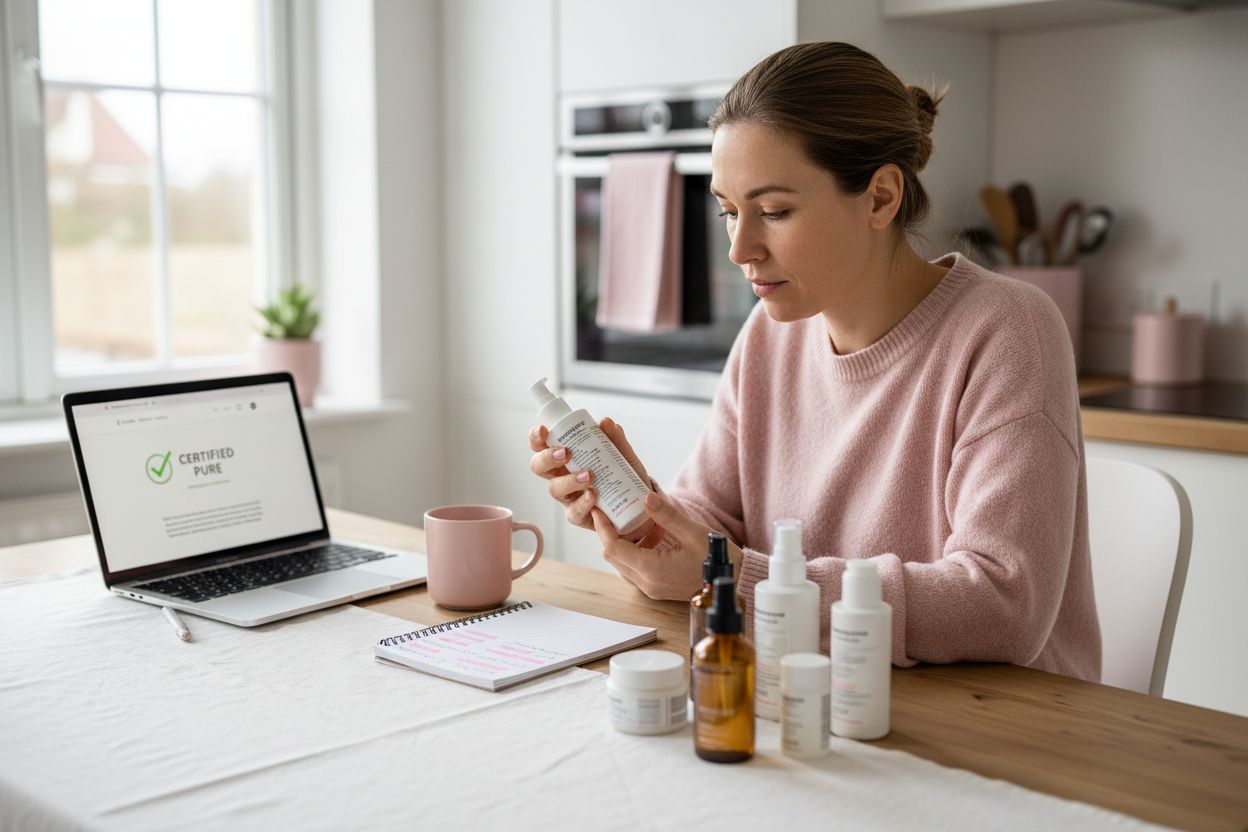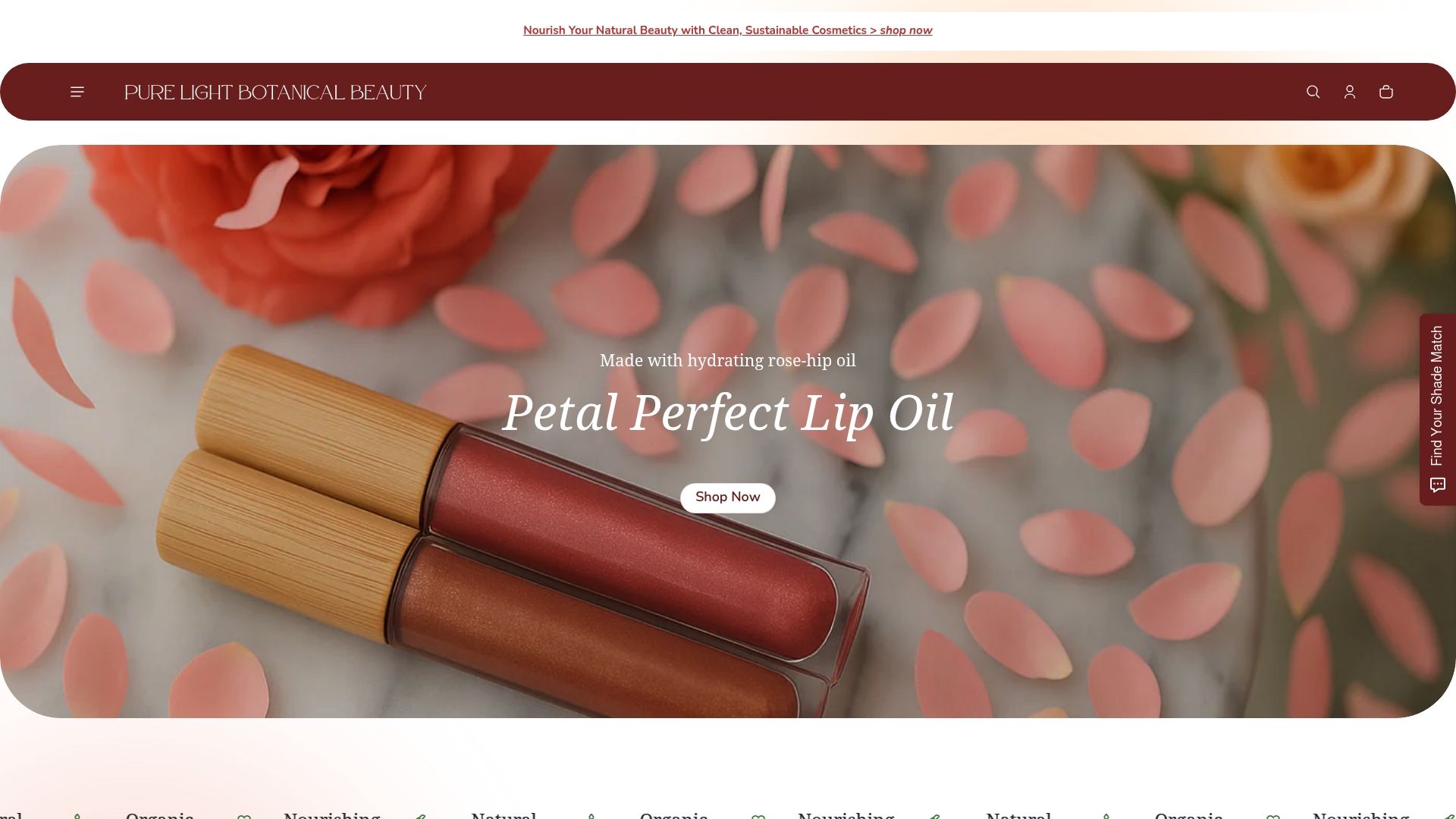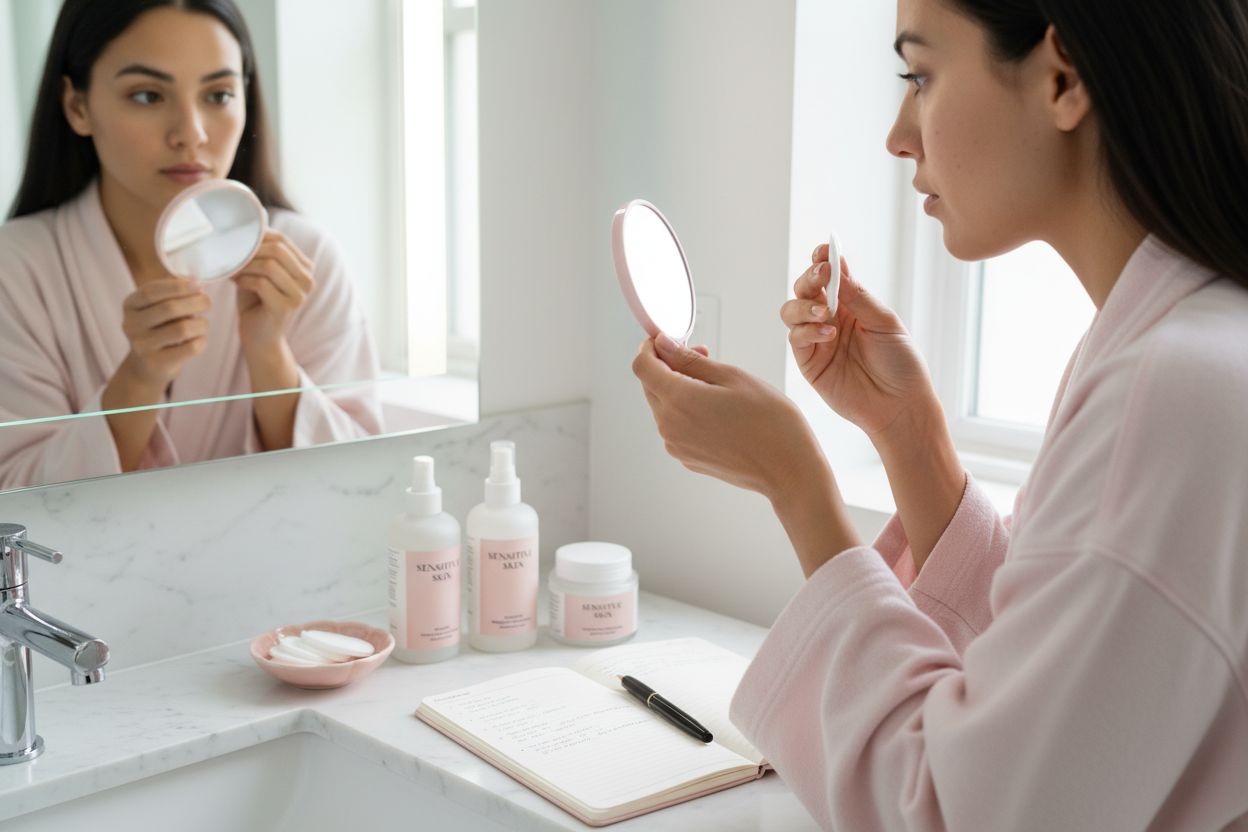Choosing clean beauty products sounds simple at first, especially if you struggle with sensitive skin. But nearly 50 percent of people with sensitive skin unknowingly react to ingredients labeled as ‘natural’ or ‘gentle’. The real surprise is that the difference between irritation and real healing comes down to steps most people skip over completely.
Table of Contents
- Step 1: Identify Your Skin Type And Concerns
- Step 2: Research Clean Beauty Brands And Values
- Step 3: Read And Understand Ingredient Labels
- Step 4: Test Products With Patch Tests
- Step 5: Evaluate Performance And Satisfaction
- Step 6: Share Your Experiences And Recommendations
Quick Summary
| Key Point | Explanation |
|---|---|
| 1. Identify Your Skin Type Clearly | Conduct a detailed skin assessment to understand your unique sensitivities and needs, documenting reactions and triggers comprehensively. |
| 2. Research Clean Beauty Brands | Look for brands that prioritize ingredient transparency and avoid harmful chemicals, ensuring they’re committed to skin health and sustainability. |
| 3. Read Ingredient Labels Carefully | Focus on primary ingredients in products, avoiding irritants and seeking out soothing botanicals that truly benefit sensitive skin. |
| 4. Always Patch Test New Products | Perform patch tests on a small skin area to monitor for adverse reactions before fully integrating new products into your routine. |
| 5. Document and Share Your Experiences | Keep a journal of your skincare journey and share insights with others to foster community support in navigating sensitive skin care solutions. |
Step 1: Identify Your Skin Type and Concerns
Understanding your unique skin landscape is the foundational step in choosing clean beauty products that truly heal and support sensitive skin. This crucial initial phase goes beyond simply knowing whether you have dry or oily skin—it’s about recognizing the intricate signals your skin sends and understanding its deeper needs.
Begin by conducting a thorough skin assessment. Stand in natural light and observe your skin’s texture, reactivity, and any recurring sensitivities. Sensitive skin isn’t just a category—it’s a complex communication system that requires careful listening. Are you experiencing redness, occasional burning sensations, tight feeling after cleansing, or frequent breakouts? These are not just symptoms but important messages from your skin.
To accurately determine your skin type, spend a few days monitoring how your skin responds to environmental changes and potential triggers. Track your skin’s behavior after washing, during temperature shifts, and when exposed to different products. Some individuals discover their sensitivity stems from underlying conditions like eczema, rosacea, or contact dermatitis—understanding these nuances is key. Read our comprehensive guide on identifying sensitive skin triggers to gain deeper insights into your skin’s unique language.
Consider creating a skin journal to document your observations. Note down:
- Specific reactions or irritations
- Products that cause discomfort
- Environmental factors that impact your skin
- Emotional and physical stress levels
This methodical approach transforms skin identification from a guessing game into a precise, personalized investigation.
Here is a checklist table to help document and track your sensitive skin assessment as described in Step 1.
| Assessment Item | What to Observe | How to Document | Example Notes |
|---|---|---|---|
| Skin Reactions | Redness, burning, tightness, breakouts | Write down specific reactions and time of occurrence | “Redness after cleansing, tightness in cheek area” |
| Product Response | Comfort/discomfort after product use | Record which product caused which reaction | “Moisturizer caused redness within 10 minutes” |
| Environmental Factors | Changes after sun, cold, or humidity exposure | Note environment and skin response | “Skin itchy after windy day outdoors” |
| Stress Levels | Fluctuations in stress or health | Track stress, sleep, illness alongside skin changes | “Breakout during exam week” |
| Progress Over Time | Patterns across several days | Keep daily notes to catch trends | “Less irritation when using minimal products” |
| Remember, sensitive skin requires patience, compassion, and a holistic understanding that goes far beyond surface-level treatments. Your skin is communicating—your job is to listen carefully and respond with nurturing, clean beauty solutions that honor its delicate nature. |
Step 2: Research Clean Beauty Brands and Values
Researching clean beauty brands transforms your skincare journey from a passive experience to an empowered exploration of wellness and transparency. This critical step moves beyond superficial marketing claims and digs into the authentic heart of beauty brands that genuinely prioritize skin health and environmental responsibility.
Clean beauty is not just a trend—it’s a commitment to holistic well-being. Begin your research by examining brand philosophies that go beyond surface-level promises. Look for companies that transparently share their ingredient sourcing, manufacturing processes, and core values. Learn more about the principles of clean beauty and understand how these values translate into actual product formulations.
Develop a strategic approach to brand investigation. Scrutinize ingredient lists with the same attention you would a nutritional label. Watch for brands that eliminate harsh chemicals like parabens, sulfates, and synthetic fragrances. Pay special attention to companies that not only avoid harmful ingredients but actively incorporate botanical healing elements specifically designed for sensitive skin.
Your research toolkit should include multiple resources:
- Verified clean beauty databases and certification platforms
- Dermatologist and skin health professional recommendations
- Ingredient transparency reports
- Community forums and user experiences with sensitive skin
Remember that true clean beauty brands view product development as a holistic healing process. They understand that skincare is not just about cosmetic appearance but about nurturing your skin’s natural balance. Brands committed to this philosophy will demonstrate a deep respect for both human health and environmental sustainability. Look for evidence of ethical practices, such as cruelty-free certifications, sustainable packaging, and a genuine commitment to supporting skin wellness through natural, intentionally selected ingredients.
Step 3: Read and Understand Ingredient Labels
Deciphering ingredient labels is like learning a complex language designed specifically for skin wellness. This step requires patience, curiosity, and a strategic approach to understanding what truly nourishes sensitive skin. Ingredient labels are not just lists—they are roadmaps to your skin’s potential healing journey.
Ingredient lists are organized in descending order of concentration, which means the first five ingredients typically comprise the majority of the product. Start by focusing on these primary components, looking for botanical extracts, natural oils, and skin-supportive elements that signal genuine clean beauty commitment. Explore our detailed guide on understanding natural ingredient benefits to deepen your comprehension of what makes an ingredient truly healing.
Develop a personal watchlist of ingredients to avoid and ingredients to embrace. For sensitive skin, steer clear of known irritants like alcohol denat, synthetic fragrances, sulfates, and parabens. Instead, seek out ingredients renowned for their soothing properties such as chamomile, aloe vera, calendula, and green tea extract. These natural components not only provide cosmetic benefits but actively support skin’s healing mechanisms.
Consider creating a reference guide for yourself that includes:
- Ingredients that consistently trigger skin reactions
- Botanical extracts known for calming sensitive skin
- Scientific names of potentially harmful synthetic compounds
- Natural preservatives that are skin-friendly
Treat ingredient label reading as an ongoing learning process.
This table compares key clean beauty ingredient types mentioned in Step 3, outlining which to avoid and which to embrace for sensitive skin.
| Ingredient Type | Typical Examples | Sensitive Skin Impact | Recommendation |
|---|---|---|---|
| Irritants to Avoid | Alcohol denat, synthetic fragrance, sulfates, parabens | Increase risk of redness, stinging, or flare-ups | Steer clear |
| Soothing Botanicals | Chamomile, aloe vera, calendula, green tea extract | Calm irritation, support healing, reduce inflammation | Choose regularly |
| Natural Oils | Plant-based oils (e.g., jojoba, argan) | Can nourish, but test for individual response | Use with patch testing |
| Synthetic Compounds | Chemical preservatives, harsh detergents | May disrupt barrier or provoke allergies | Avoid when possible |
 Your understanding will evolve with each product you examine, gradually building a nuanced knowledge of what truly supports your skin’s unique needs. Remember that transparency is key—brands committed to clean beauty will make ingredient information accessible, clear, and comprehensible, reflecting their genuine dedication to consumer health and wellness.
Your understanding will evolve with each product you examine, gradually building a nuanced knowledge of what truly supports your skin’s unique needs. Remember that transparency is key—brands committed to clean beauty will make ingredient information accessible, clear, and comprehensible, reflecting their genuine dedication to consumer health and wellness.
Step 4: Test Products with Patch Tests
Patch testing is your personal safety protocol—a critical defensive strategy that transforms potential skin risks into a controlled, mindful exploration of new beauty products. This step is not just a recommendation, but a non-negotiable ritual for anyone with sensitive skin. Think of patch testing as creating a protective boundary between your delicate skin and unknown product formulations.
Begin by selecting a small, discrete area of skin typically hidden from view—the inner forearm or behind the ear are ideal locations. These areas provide an excellent testing ground that allows you to monitor reactions without widespread exposure. Learn more about safe product testing techniques to ensure your skin’s optimal protection during this process.
The patch test procedure requires patience and systematic observation. Apply a small amount of the product to a clean, quarter-sized area of skin and leave it undisturbed for 24 to 48 hours. During this period, resist the urge to wash the area or apply additional products. Watch carefully for any signs of potential reactions such as:

- Redness or unusual skin discoloration
- Burning or stinging sensations
- Itching or raised bumps
- Swelling or inflammation
- Unexpected dryness or flaking
Document your observations meticulously. Consider taking dated photographs to track any subtle changes that might not be immediately apparent. If no adverse reactions occur within the 48-hour window, you can gradually introduce the product into your skincare routine, starting with minimal application and slowly increasing frequency. Remember that sensitivity can be cumulative—what seems harmless initially might trigger a response after repeated use. Your skin is communicating constantly, and patch testing is your method of listening intently to its nuanced language of health and protection.
Step 5: Evaluate Performance and Satisfaction
Evaluating product performance is an intimate dialogue between your skin and the clean beauty solutions you’ve carefully selected. This step transcends mere cosmetic assessment—it’s a holistic exploration of how products genuinely interact with your unique skin ecosystem. The evaluation process requires patience, mindful observation, and a commitment to understanding your skin’s evolving needs.
Begin by establishing a consistent observation timeline. Commit to using the product for at least four to six weeks, allowing your skin sufficient time to adjust and reveal its true response. Discover more insights about tracking skin transformation to enhance your evaluation approach. Track changes not just visually, but through sensory and emotional experiences. How does your skin feel throughout the day? Are you experiencing increased comfort, reduced sensitivity, or improved overall skin resilience?
Document your journey with intentional reflection. Create a dedicated skin journal where you record nuanced observations beyond surface-level changes. Pay attention to subtle shifts in skin texture, hydration levels, and your skin’s natural healing capabilities. Unexpected improvements might emerge—reduced inflammation, more balanced oil production, or enhanced skin barrier function.
Consider tracking these key performance indicators:
- Skin comfort and reduced reactivity
- Texture and smoothness
- Hydration levels
- Overall skin tone and evenness
- Emotional well-being and confidence
Remember that true product satisfaction extends beyond immediate cosmetic results. A remarkable clean beauty product should make you feel supported, nurtured, and connected to your skin’s inherent healing potential. Trust your intuition—if a product doesn’t resonate with your body’s wisdom, it’s okay to discontinue use and continue exploring solutions that genuinely honor your skin’s unique journey.
Step 6: Share Your Experiences and Recommendations
Sharing your clean beauty journey transforms personal discovery into collective healing—a powerful act of community care and empowerment. Your experience is not just a story, but a beacon of guidance for others navigating the complex landscape of sensitive skin solutions. By openly communicating your insights, you contribute to a broader understanding of holistic skincare and support others seeking genuine wellness. Explore our community sharing platform to connect with like-minded individuals on similar journeys.
Approach sharing with authenticity and compassion. Your narrative should encompass both the triumphs and challenges encountered during your clean beauty exploration. Detailed, honest accounts provide invaluable context for those feeling overwhelmed or isolated in their skin sensitivity struggles. Discuss not just product performance, but the emotional transformation you experienced—how finding the right skincare felt like reclaiming control over your body’s narrative.
Choose platforms that align with your comfort level and amplify meaningful dialogue. Online beauty forums, social media groups dedicated to clean beauty, brand review sections, and personal blogs offer diverse channels for sharing. When crafting your recommendation, focus on providing actionable insights that go beyond simple product praise:
- Specific skin conditions or sensitivities you addressed
- Ingredient combinations that worked effectively
- Unexpected benefits or transformative experiences
- Practical application tips
- Emotional impact of finding suitable products
Remember that vulnerability creates connection. By generously sharing your journey, you’re not just recommending products—you’re building a supportive ecosystem where individuals with sensitive skin feel seen, understood, and empowered to pursue their unique path to wellness. Your voice matters, and your experience has the potential to guide someone else toward healing and self-acceptance.
Discover Gentle Relief and Confidence for Sensitive Skin
If you have struggled with the frustration of redness, irritation, or never quite knowing how your skin will react next, Pure Light Botanical Beauty offers a place where skincare and compassion meet. The journey you began by researching clean beauty, reading labels, and patch testing deserves a brand that understands every nuance of sensitive skin. Pure Light Botanical Beauty specializes in plant-based, clean formulations that soothe and nourish skin challenged by eczema, sensitivities, and everyday stress. Here, makeup becomes a ritual of self-care and confidence, not just coverage.

Ready for relief you can feel and radiance you can trust? Explore our collection crafted for your peace of mind and your unique glow. Visit Pure Light Botanical Beauty to find skin-friendly options designed for sensitive skin, or deepen your journey toward healing and transformation by learning more about how clean botanical beauty supports sensitive skin. Your gentle transformation starts now—give your skin the healing power it deserves today.
Frequently Asked Questions
How do I determine my skin type before choosing clean beauty products?
To determine your skin type, observe your skin’s texture, reactivity, and any sensitivities. Track your skin’s behavior over a few days, noting reactions after washing or exposure to different products. Documenting your observations can help you identify specific skin concerns.
What ingredients should I avoid in clean beauty products for sensitive skin?
Avoid known irritants such as alcohol denat, synthetic fragrances, sulfates, and parabens. Instead, seek products with soothing ingredients like chamomile, aloe vera, calendula, and green tea extract, which can help calm and support sensitive skin.
How can I effectively patch test new skincare products?
Select a small area of skin, like the inner forearm, and apply a small amount of the product. Leave it for 24 to 48 hours without washing or applying additional products. Monitor the area for any signs of reactions such as redness, itching, or swelling before using the product on your face.
What should I track when evaluating the performance of clean beauty products?
Track skin comfort, texture, hydration levels, and overall tone. Document any changes in skin sensitivity and emotional well-being. A dedicated skin journal can help you observe patterns and determine if a product meets your skincare needs.
Recommended
- 7 Clean Beauty Routine Ideas for Sensitive Skin Relief – Pure Light Botanical Beauty
- How to Choose Natural Makeup for Sensitive Skin Relief – Pure Light Botanical Beauty
- Understanding Why Clean Beauty Works for Your Skin – Pure Light Botanical Beauty
- 7 Botanical Ingredients List for Sensitive Skin Relief – Pure Light Botanical Beauty
